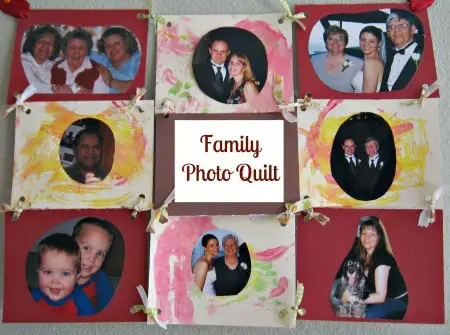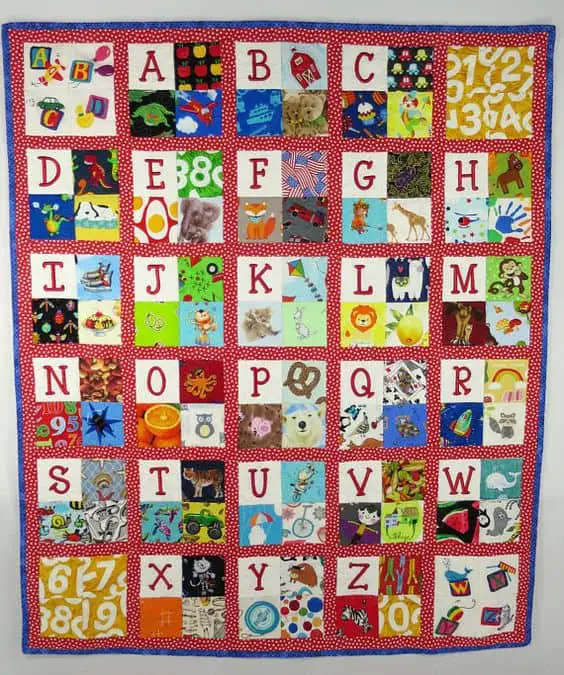Fun Activity Quilts for Kids of All Ages
Quilted projects come in all shapes and sizes. Some are meant to keep you warm, some are meant to decorate your walls or tables and some are meant to be quite useful. Activity quilts fall into the useful category, but they are also tons of fun.
Activity quilts come in all shapes and sizes too. They can be as big as a bed and include games for a whole family, or they can also be as small as a book for quiet time activities for toddlers. Read on to learn what activity quilts are, who they are meant for, what to include on them and a tips and tricks section to help you out.
What is an Activity Quilt?
Activity quilts are quilted projects that include a variety of different interactive activities. They may include things like game boards to use for two or more players. They could also be meant as a way to improve or remember a skill such as tying a knot and bow with shoe laces.
While there are patterns available for activity quilts, your options are truly limitless. Once you get started with them, you will think of so many other fun items to add or different ways of using them.
You will learn about three different categories of activity quilts here. No matter their age, we have something for everyone on your list.
Three Categories of Activity Quilts
1. Alzheimer’s and Dementia Lap Quilts
One of the best uses of activity quilts is for helping people who are dealing with Alzheimer’s or dementia. These are usually small quilts that they can hold easily while completing the activities. The activities help them to remember how to do ordinary tasks such as buttoning a button, using a zipper or snapping a pocket closed and you may know them as “fidget quilts.”
These lap quilts are great for stimulating their muscles to keep their hands from getting stiff and sore or to give restless hand something to do. Sometimes people with Alzheimer’s or dementia get agitated easily or become confused. These lap quilts can help soothe them when this happens because it preoccupies them.
When possible, using real clothing for the buttons or snaps is great because it gives a real context to relate to. For a belt buckle, use a real belt and simply cut off the extra. Keep things as close to normal-looking as possible so they can really relate to the items they are working with.
While using clothing from a loved one who has passed is great for making a memory bear or pillow, it is not recommended for the lap quilts because it may bring about unwanted feelings. Keep loved ones clothing simply for mementos.
For these lap quilts, it is important to keep it light-weight and lap-sized so that it is easy to maneuver. Also, try to use colors and patterns that they enjoy because having something that is visually pleasing also helps to calm and soothe many people.
You can make these for your own friends and family. You could also make some to donate to hospitals or nursing homes. Check with the facility first to see if they have any restrictions on what can be added to the quilts.
2. Family Activity Quilts
Activity quilts meant for the family are often made in large sizes to accommodate many different activities, such as game boards. These could each be made into their own separate quilted project as well. It is totally up to you.
These often have a variety of game boards with zippered pockets on the quilt or a separate accessory bag, to hold pieces and pawns. The game pieces and pawns could be sewn, cut-out of felt or you can purchase them. Checkers and chess pieces are readily available online.
Story squares are popular for family activity quilts and involve the whole family. Each square has a flap with a picture behind it, such as a house, an animal or any object. Include many different people, places and things.
One person chooses a flap to look under and begins that story with that picture. Each person takes a turn lifting another flap and continuing the story while integrating the new picture. Choosing a different order each time will give you a different story each time.
Family activity quilts are awesome for camping trips, hotel stays or just a family fun night at home. They are perfect for out-of-town guests too. Leave them in the room they will be using so they will have something to do when they are not visiting with you.
These make wonderful gifts for family and friends. They can also be donated for school fundraisers or charity raffles. They are perfect for homes that provide temporary housing for families of children receiving long-term care as well.
3. Quiet-Time Activity Quilts for Kids
Please realize that quiet-time quilts do not necessarily mean that a child should or will be quiet while playing with it. Some parents refer to certain times of the day as quiet time. During this time, children may do activities that are not over-stimulating to the senses.
These activity quilts are excellent for keeping little ones occupied just before nap time so they can wind down a bit. They are also wonderful for car rides or waiting rooms. They may even be used in a shopping cart.
The size of activity quilts for kids should depend on the child and how it will be used the most. If it is going to be used for traveling in the car, then it needs to be lap-sized. For this, you could sew multiple small quilted activities into one “book” for them to hold.
If they will be using them mainly at home, then a larger one would work. You could always put each activity on its own mat and then store them all in one take-a-long tote together. They could pull out one at a time but still have access to all of them.
Be sure that the items are age appropriate. For example, a toddler should not be using chalk which can be accidentally swallowed, but an older child could use it. Chalkboard fabric is easy to sew and gives them a great reusable canvas for drawing.
Quiet-time activity quilts should have items that are not frustrating for the kids to do on their own. They are meant to occupy their time with skills that they already know.
If they already know how to use buttons or snaps well, then include those items. If they do not have a lot of experience with something, then either leave it off or practice it with them before having them use it on their own.
Consider donating these quiet-time activity quilts to children’s’ wards in hospitals. They would also be great for foster care organizations to give children while they are transitioning homes so they have something that is their own. Of course, have some on-hand for kids and grandchildren too.
Items That Can be Included on an Activity Quilt
Here you will find suggestions of what to add for all of the categories of activity quilts discussed above. Do not limit yourself to these ideas, but use them to get your creativity flowing.
1. Alzheimer’s and Dementia Lap Quilts
– Zippers: Use short zippers so they are not too frustrating
– Buttons: Use larger buttons, preferably on real clothing, such as a sleeve cuff.
– Beads: These can be on a ribbon that is sewn down on each end so that the buttons can be moved back and forth on the ribbon without being removed completely.
– Snaps: A flap with a snap, such as a shirt pocket, would be perfect for this.
– Laces: Sew down the middle of an extra-wide shoe lace so the rest can be used to tie knots and bows.
– Ribbon loops: Include a piece of yarn that can be pulled through the ribbon loops.
– Buckle: Use an actual belt buckle or shoe buckle.
2. Family Activity Quilts
– Game boards: You can find patterns for, or create on your own, game boards for chess, checkers, backgammon and more.
– Hopscotch board: Include a pocket for little bean bags that you can sew to use in the place of rocks.
– Zipper pocket games: You can add smaller games like card games or dice games to your activity quilt simply by sewing on pockets to hold them.
– Chalkboard fabric: This is perfect for playing hangman, the initial game or just drawing pictures.
– Story squares: As mentioned above, these are great for creating stories together. You could cut pictures out of different fabrics, purchase pre-cut felt shapes, or piece together an appliqué for the different pictures.
– Tic-tac-toe board: Include some X and O pieces in a nearby pocket. Be sure to have five of each.
3. Quiet Time Quilts for Kids
– Pocket for small stuffed animal: If it is a stuffed dog, make the pocket in the shape of a doghouse. For a sea animal, make the pocket in the shape of a wave.
– Chalkboard fabric: Be sure to include a pocket for the chalk and a scrap of fleece or flannel for erasing.
– Neighborhood map: A map with roads is a great place to play with toy cars. It could also be used to build houses or castles on. Be sure to attach a pocket for the pieces or remember to keep them in the same tote as the quilt.
– Funny faces: For this activity, stitch a blank face onto the quilt. Include either felt pieces or quilted pieces for the eyes, eyebrows, nose, mouth and hair. Be sure to have multiple of each and include accessories such as earrings or bowties too.
– Numbers and letters: Make quilted numbers and letters or simply write them on felt squares with a permanent marker. Add Velcro backs to be used along a Velcro strip to count and to practice alphabetical order.
– Matching activities: Using quilted pieces or felt cut-outs to create matching activities for colors and shapes.
– Beads: Create ribbon channels as mentioned above, or have a pouch for beads with a string that has only one side sewn down so they can practice stringing beads.
Tips and Tricks for Creating Activity Quilts
1. The activities will be on the quilt-top. You will still put batting under that and a backing on it so that you can quilt together the whole thing.
2. Be sure to quilt in between activities, especially if it is a larger quilt. You can use stencils or free motion quilting.
3. For those with Alzheimer’s and dementia, consider adding items to their activity lap quilts that have personal meaning to them. For example, if they used curlers in their hair each day, then attach a curler to a loop of ribbon. For some, this may help spark memories, but for most will bring a feeling of calm simply because of the familiarity.
4. Use different textures. Have an area with fur-like fabric because it can be soothing to pet. Texture could also come from yarn, tulle, lace, flannel, fleece or ribbed knit fabric.
5. When using chalkboard fabric, be sure to season it according to the directions before giving it away. It is super easy and makes erasing easier.
6. Consider using clear plastic vinyl for any pockets so you can easily see what is inside. It really is easy to sew. Simply go slowly.
7. Most pieces will be appliqued on. Use two-sided fusible interfacing or a spray bond to hold them together, and then stitch around the outside with a machine or by hand.
Enjoy making activity quilts for loved ones in your life or for donations. You will feel good making them for other and the recipients are sure to love them too!

